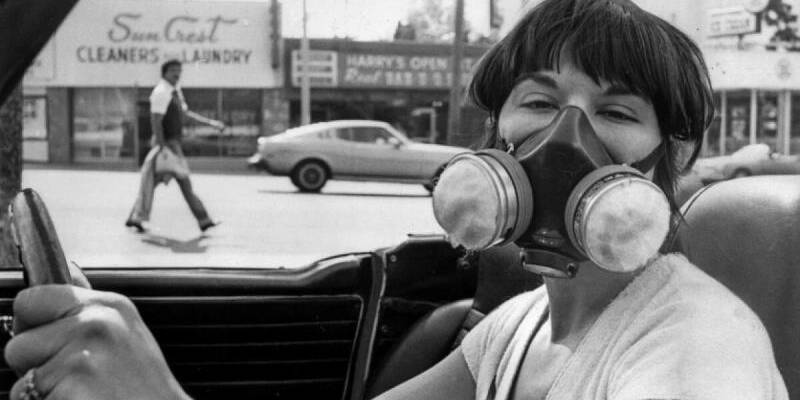
As the fight over the Long Beach Freeway extension drags into its fourth decade, scores of homes the state has acquired in the road’s pathway have been allowed to degenerate, fall vacant and become vandalized, records show.
Despite legal provisions requiring the state to maintain its properties, The Times found that more than 100 homes, including many valuable landmark houses, are so decrepit they can no longer be rented out, blighting what were once well-kept neighborhoods and depriving government coffers of rental income and property tax revenue.
Many of the more than 600 houses the state has accumulated are now surplus due to a change in the freeway route years ago. Their total value is about $27 million, but state officials have taken no steps to sell them.
Eventually, the state needs to acquire about 1,000 more properties in the path of the 6.2-mile freeway spur running from Alhambra to the Foothill Freeway in Pasadena. The $1.4-billion construction job is not expected to begin for at least another decade.
Top officials at the state Department of Transportation who manage the housing say they are doing a good job, despite a lean budget.
“Basically the homes that we own are in pretty good condition . . . compared to our neighbors,” said Jack Hallin, interim director of the Caltrans office in Los Angeles. But others at the agency disagree.
“Negligence, ignorance and wastefulness” have characterized the agency’s care of historic homes, one planner wrote last year.
In frustration, some neighbors have dug into their own pockets to make repairs after Caltrans failed to renovate uninhabitable houses that attract vagrants and crime. Tenants have sometimes sued. One collected $15,000 after she was injured when a waterlogged ceiling that she had complained about crashed down on her head.
“They are worse than slumlords,” said attorney Chris Sutton, who represents several tenants who have sued Caltrans.
A Times review of agency records and property files shows that:
* Nearly a quarter of the Caltrans houses are uninhabitable or vacant, in spite of a 1973 federal court order requiring the state to make its “best efforts” to maintain the properties.
* Caltrans has failed to sell off 110 homes that have been surplus, in most cases since 1986, even though state law requires the agency to sell excess land. State highway funds are now so tight that Caltrans is planning to lay off about 300 employees here.
* Despite strict national guidelines requiring that historic landmarks be carefully preserved, many of the agency’s 69 vintage homes have deteriorated badly. More than a dozen are rotting and vacant.
* The agency has poorly managed its maintenance budget and hired firms accused of overbilling and shoddy repair work.
* Five Caltrans employees and three other state workers rent freeway houses, with some of them often delinquent in paying rent. Three relatives of ex-local Caltrans director Jerry Baxter have also lived in or tried to rent houses. One property rented by a Baxter relative received about $28,000 in repairs, while other nearby homes deteriorated.
Baxter, who left the agency last year for a top post at the Metropolitan Transportation Authority, declined to be interviewed. Auditors reported preliminarily that his relatives received no special treatment, but the matter remains under review. Officials said privacy rules barred them from disclosing the state employees’ rental arrangements.
Caltrans Director James van Loben Sels told The Times last week that he is dissatisfied with management at the Los Angeles office and would like to see the agency get out of the housing business.
In Los Angeles, Hallin and his aides acknowledged that some historic homes have decayed and promised to pump $3.5 million into renovations soon. They said that scores of the 610 Caltrans homes are unoccupied and need repairs, but that no laws had been broken.
Critics argue that the agency’s substandard properties violate a 1973 court order requiring Caltrans to use its “best efforts” to maintain its properties and rent them out to “prevent vacant structures from becoming public health and safety hazards.” The injunction was secured by South Pasadena and public interest groups trying to stop freeway construction and impose stronger environmental controls.
Antonio Rossmann, legal counsel for South Pasadena, said the pattern of neglect documented by The Times shows that the agency has breached the court order. “That Caltrans has systematically broken the injunction transcends legal compliance, it becomes a public disgrace,” he said.
Caltrans collects millions of dollars a year by renting the houses for $300 to $2,300 a month. Most of this money has been plowed into other Caltrans operations, officials said. While $5 million was collected by Caltrans from homes in Los Angeles and Ventura counties last year, only about $1.8 million was allocated for their maintenance.
Along the proposed Long Beach Freeway extension, no rent was collected on a quarter of the Caltrans properties because they are vacant. Records show that 106 of the 157 vacant homes are uninhabitable.
Two boarded-up houses in the 2000 block of Berkshire Avenue in South Pasadena have long been community eyesores and together need $125,000 in repairs, according to Caltrans’ estimate last year.
One is a Spanish-style bungalow-with buckled floors, collapsed ceiling and blistering paint-that has been empty for a decade. Arson fires have hit twice during the 17 years Caltrans has owned it, records show. The other house, vacant at least seven years, is riddled by dry rot and termites.
Typically, complaints to local health and building officials go nowhere, because Caltrans, like other state agencies, is exempt from compliance with local regulations.
If Caltrans’ properties were not exempt, “they’d have bundles of violations,” South Pasadena City Manager Kenneth Farfsing said.
There has been a smattering of violations issued against Caltrans’ properties for various problems such as sewage backups and fire dangers, records show.
Generally, unhappy citizens have just one place to turn-Caltrans.
Neighbors, city officials and the local assemblyman have written at least 14 letters since 1990 beseeching Caltrans to restore the Berkshire Avenue houses.
The agency agreed a year ago to begin major repairs soon. But the houses remain untouched.
Joe Boyd, Caltrans deputy director in Los Angeles, told The Times that work would not begin until next month. “Some of the things we said were going to come true, didn’t,” he said.
Fed up with the state’s inaction, neighbors in some cases made repairs on their own. South Pasadena resident Philip Stocker said he spent $6,000 fixing up a neighboring Caltrans home. “I gave up on complaining,” he said.
In Pasadena, homeowner associations and preservationists have battled nearly 25 years to force Caltrans to maintain its vintage houses located just a block away from upscale Orange Grove Boulevard, documents show.
“Their record is deplorable,” said Claire Bogaard, former director of Pasadena Heritage. “Year after year, they’ve promised action and yet they’ve done nothing.”
Caltrans owns 69 homes that are listed with the National Register of Historic Places or are candidates for landmark status because of their age and design significance. Federal and state laws prohibit neglect of these properties and require that repairs meet strict guidelines.
Once architectural gems, many houses are now empty caverns with rotting wood, buckling floors, waterlogged plaster, rat infestations and scattered trash. Fifteen are unrentable, records show. Some have been vacant for almost a decade.
In one Craftsman-style home in Pasadena, the front door is unlocked. Vagrants, using candles for light, have left burn spots on the floors and fouled toilets that are not working.
A few doors away on St. John Avenue, a vacant 98-year-old house with a weather-beaten facade and shattered windows has been stripped of its antique hardware and fixtures.
Caltrans environmental planner Ronald Kosinski last year itemized extensive repairs needed at the eight historic homes most heavily damaged by the agency’s neglect, vandalism or careless workers. He warned colleagues to rethink their “penny-wise, pounds-foolish” policy that has “alienated . . . communities and put Caltrans on the defensive.”
Upon learning of the decay, Elizabeth Merritt at the National Trust for Historic Preservation, said, “I’m really appalled. We knew there was a problem, but nothing this bad.”
Meanwhile, residents in working-class El Sereno have been complaining since the 1980s about uneven upkeep of Caltrans property, rent hikes, pest infestations and empty houses.
In the 3000 block of Sheffield Avenue, 10 Caltrans homes recently were either boarded up or vacant. One was a crash pad, with gang tags adorning the walls. The air reeked of refuse and urine. Out back, mattresses were piled high in an open garage with exposed electrical wires.
Caltrans officials said most of their homes are in good repair and tenants overall are satisfied. But they said budgetary constraints limit the repairs they can undertake.
“The (historic) houses are older. They really need a lot of work,” said Caltrans property chief Theo Walker in Los Angeles. “But if you have X dollars in your budget, you can only do certain things.”
Records show that the agency is sitting on $27-million worth of homes that became surplus years ago when the proposed freeway was rerouted to spare downtown South Pasadena and other historic enclaves. Yet a state law passed in 1979 requires the state to sell off excess residential property.
“They should sell the excess homes and pour the money into the remaining ones,” Pasadena activist Lorna Moore said.
Caltrans officials said it is premature to sell them because the proposed freeway route has not yet won federal approval. They said the old path, which the state transportation commission has officially rescinded, might be resurrected someday. They also noted that sale proceeds would go to the state general fund, and not necessarily into renovations.
The Times reviewed hundreds of internal Caltrans records showing that officials often have been slow to make repairs, paid uneven attention to properties and made questionable expenditures on certain homes.
Boyd said there may be an occasional expenditure that “didn’t make sense,” but said that overall the maintenance program is managed wisely.
In several instances, The Times visited vacant and deteriorated homes with crystal-clear swimming pools that had been regularly maintained. In another case, records show the agency paid a contractor an hourly rate of $23.50 to water a lawn.
Instead of repairing or replacing the roof on an El Sereno property recently, Caltrans paid more than $800 both in 1993 and 1994 to cover it with a tarp, records show.
Meanwhile, Eustace Cox, a disabled engineer, said a plastic tarp has covered his leaky roof in Pasadena for the last two years because Caltrans officials told him that there was no money for non-emergency repairs. “They said all the homes will be refurbished (someday), but they’ve said that for years,” Cox said.
While many homes have decayed, records show that Caltrans invested nearly $28,000 in one Pasadena house during a three-year period, including almost $15,000 for interior paint and floor refinishing. Caltrans auditors found that one of the tenants was a relative of Baxter, the former Caltrans official.
Auditors concluded that Baxter’s relative received no special treatment, nor did his children who lived in or tried to rent freeway houses on two other occasions.
Baxter’s daughter briefly rented a home a decade ago. Last year, Baxter personally asked for a list of vacant Caltrans homes in Pasadena and went with his son to pick out a place. When he discovered that the only one he wanted was claimed, Baxter was agitated, recalled Caltrans rental agent Billye Tate.
Jim Drago, Caltrans chief spokesman, said he believed that Baxter’s efforts on his son’s behalf were ill-advised but not illegal. “It’s fair to say it’s inappropriate,” he said.
Criticism has been leveled against other Caltrans officials directly in charge of maintaining the freeway homes, according to audit reports.
Acting on allegations from a whistle-blower in 1991, auditors concluded that officials overpaid contractors doing yard and lot cleanup work, approved checks for repairs before the jobs were started, and paid for work that had to be redone.
They overspent their budget by about 25% three years in a row, for a total of $3 million in overruns, records show. Part of this was caused by a $600,000 expenditure to re-sod lawns-a job that auditors determined was not properly supervised and was awarded without competitive bidding.
In another matter, auditors are reviewing the bills that Vipel Construction of Buena Park has submitted to Caltrans during the last three years to determine if the company “submitted altered receipts to support their invoices,” according to an auditor’s confidential report.
Vipel President Joseph Thankachen said he was unaware of any review and said there are no billing improprieties.
Caltrans officials acknowledged some oversight troubles, and said a new computer system has helped correct billing and scheduling problems.
Auditors also have investigated allegations that some contractors curried favor with Caltrans property officials or received favorable treatment.
Auditors inquiring into accusations that Caltrans employees had received “gifts and services” from contractors were not able to substantiate that any presents had changed hands. Sources, however, told The Times that they have seen colleagues accept gift baskets, food, alcohol and a watch.
Caltrans rental agent Daniel Soroky recalled that he was offered a gold coin several years ago by an executive of a company that contracts with Caltrans.
“I was flabbergasted. It was the size of a quarter,” said Soroky, who did not accept the coin. “I didn’t think it was appropriate.”
For tenants, the quality of repair jobs by Caltrans contractors has sparked many complaints, records and interviews show.
Doug Hoover, a former Caltrans rental agent who was transferred two years ago to another division, recalled phone calls from numerous tenants upset by shabby or incomplete repairs.
“You could tell many of the contractors didn’t have the faintest idea what they were doing,” Hoover said. “But the ones that got all the complaints kept being invited to bid again. . . . What makes me so frustrated was that this was our tax dollars going down the drain.”
Lyn Miller, who rents a historic house in Pasadena, complained in a letter to Caltrans about an electrician who knocked out electrical service to half of the house, as well as another repair firm that installed an unvented water heater that emitted “lethal fumes.”
Another tenant, Harry Nickelson, is suing Caltrans for $512,000 in damages, alleging that contractors Caltrans hired in 1993 improperly removed his apartment’s asbestos-containing flooring and contaminated his possessions.
The South Coast Air Quality Management District has slapped Caltrans and two of its contractors with notices of violation for failure to follow state regulations for handling and disposing of asbestos in this case.
The asbestos incident was not Nickelson’s only brush with botched repair work.
Exterminators hired to eliminate rats from his current rental used poison and traps that killed the rats inside the walls but left a horrible stench, he said.
Then, during the storms this winter, he said the roof leaked so much that a 6-by-8-foot swath of plaster came loose from the living room ceiling.
Looking at the bright side, Nickelson noted that Caltrans did dispatch a plumber to fix a few things.
“They fixed the faucet drips and my dishwasher while the roof was leaking like a sieve,” he said. “When I take people into the house, I have to apologize.”
copyright Los Angeles Times
Related Posts
The Brown Air Prequel for our Climate Change World
Why the Sky Disappeared, and Why L.A.'s Smog-Choked…
At Christmas, “It’s A Wonderful Life.” In 2022, hopefully it’ll be a series about a life as Impossible as it is Strange!
Mercury Media has optioned its inaugural title, the…




